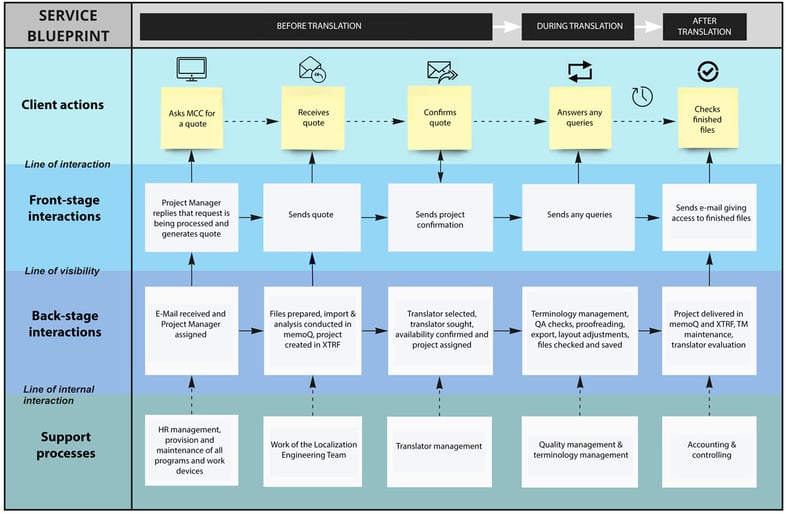
It’s common in the translation industry for clients to care about nothing more than the end product and the price. But the translation process involves a lot more than meets the eye. Our In-House Linguist and Project Manager Julia Wuggenig explains what lies beneath the surface.
What clients think vs. the reality
“Really? It involves all of that as well?” – this, along with a look of surprise, was one of the most common reactions Julia Wuggenig got when she talked to MEINRAD clients about the translation process as part of her Master’s thesis. It shows that there’s a big gap between what actually happens in order to produce a translation and what clients are aware of. With her thesis, Julia has begun to bridge that gap by highlighting the numerous steps involved in the translation process which usually go unnoticed by clients.
Price isn’t everything
Many clients decide to use a particular translation service provider based on the price, without having any opportunity to assess the quality of what they deliver. Unlike other products, it can be very difficult to judge how good a translation is – particularly if you don’t speak the target language, in which case it’s effectively a question of blind faith that the end product is correct. So it’s little surprise that clients usually make their decision based on something they can actually see: the price. This means it’s even more important to make clear where their money is going and explain that price isn’t everything.
Making the invisible visible
Julia decided to do something about that. She joined MEINRAD while she was studying for her Master’s degree, and in her work as a Project Manager she kept noticing that clients who were not from the translation sector usually didn’t know what the translation process actually involves. She also knew that there are invisible steps which can have a big impact on the quality of the finished translation, such as:
- Managing terminology
- Designing the layout
- Maintaining translation memories
- Proofreading/checking to ensure source texts are suitable for translation
- Quality control
But steps that happen in the background can’t easily be used to demonstrate a high-quality product and therefore to justify the price an agency charges, so Julia quickly realized that research and action was needed. In her thesis she developed a service blueprint – a technique long used in the service sector to show the service delivery process and highlight the potential for optimization – specifically for the translation process.
Julia’s service blueprint identifies the following:
1. Steps visible to the client
- Client actions: The top level is the metaphorical tip of the iceberg, i.e. everything the client is actually aware of in the translation process. These are the classic touchpoints with the translation service provider: the client requests a quote, gets the quote, and ultimately gets the finished translation.
- The front-stage interaction: Client actions are separated from the front-stage interactions by what’s known as the “line of interaction”: the staff actively in contact with the client who go through all processes together with them. These actions include sending quotes, responding to queries and delivering the finished translation.
2. Processes running in the background
- The back-stage interaction: This is where the invisible process begins, separated by the “line of visibility”. These are all the steps the client is unaware of but are crucial to enable the front-stage interaction, and by extension the overall project, to run smoothly. They include assigning the project to the respective project manager, preparing and analysing the source files, finding and selecting a suitable translator, managing terminology and designing the layout.
- Support processes: There are also numerous hidden but vital processes which create the foundations for the agency to exist in the first place and deliver translations. These include the work done by the localization engineering team, who are responsible for the often time-consuming process of preparing data and for ensuring that all software works correctly.

Complete transparency
This diagram gives clients a clear overview of each individual step in the complex translation process, and helps avoid misunderstandings that clients, project managers and translators may have. And it begins with the quote: as a result of Julia’s thesis, the quote we send to a client now features the steps involved in delivering the translation, meaning that clients no longer have to rely on the price alone as the sole quality indicator. That means we can clearly demonstrate exactly what services we’re providing, and clients can rest assured that they’re not buying a pig in a poke. It also helps technical writers looking for a new translation service provider, as they now have a much more solid basis to make the case for choosing a particular agency.
Shining a light on what goes on behind the scenes to produce a translation
In an increasingly digital world, and one in which machine translation is making its presence felt, this service blueprint can play a major role in “unmasking” the anonymity of the translation process and highlighting what often goes unnoticed. It shows that the finished product is the result of the hard work of lots of highly talented people – and no matter how much technology advances, this human element will always be required. MEINRAD believes that translation service providers, and in fact the service sector as a whole, can benefit enormously from awareness of these aspects and from making clear the real value of the services they provide.
Main image: © MEINRAD

